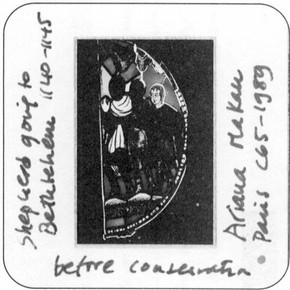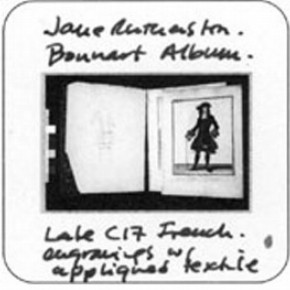Conservation Journal
October 1997 Issue 25
Conservation Under the Microscope: Two Reviews of RCA/V&A Conservation 1997
'I wish I could say that I came all the way just to see this - if I could, it would have been worth the journey alone. Nevertheless, I'm thankful for my great timing.'
These words were written in the Conservation Course Exhibition comments book by a visitor from South Africa and one could certainly not wish for a more ringing endorsement. It has to be admitted that the lady in question revealed that she was a conservator and therefore could be regarded as biased, but nonetheless it is the sort of enthusiastic reaction which any exhibition organiser would cherish.
The Conservation Course was established in 1989 and has established an enviable reputation worldwide for its quality and for the achievements of its students. So we can take for granted the fact that this year's graduating class was both skilled and well trained, each one ready for a career in his or her chosen field. However, this would not necessarily have meant that what they did during the course would make an interesting public exhibit or that the students themselves would be capable of putting on an exhibition which is up to the standards expected of a display in the V&A. I therefore tried to judge the exhibition as an exhibition, making no allowances for the somewhat accidental nature of its contents or the relatively inexperienced nature of the exhibitors.
The display was well laid out, given the cramped conditions imposed by the restaurant lobby. The cases consisted of simple and clear displays of objects, both before and after conservation, and the main explanatory texts were attached to screens and walls. These text panels were professionally produced, easy to read, and informative. Modern museum interpretation was provided by an interactive video dealing with the stained glass conservation project displayed alongside. This interactive was easy to operate, worked efficiently and provided good and varied information. In all these ways, the exhibition could be considered as a professional production, albeit working on a very limited budget (a factor sadly common to all museum displays today).
But an exhibition is only as good as its content and here there can be no doubt that a fascinating range of works and problems was presented. Contemporary furniture and appliances, medieval glass, Victorian painting, Japanese screens and paper conservation were all on show and the various treatments illustrated. Some questions were posed (should we be trying to conserve the whole of a 1952 television set, when the electronic components, which are often unstable, are not integral to its design?), but not answered - we were left wondering how the debate would be taken forward. It is no bad thing to leave the visitors with questions in their mind and the exhibition eloquently revealed the range of problems which any conservator faces.
So I am happy to agree with our South African visitor that this was a show well worth visiting the V&A for, wherever you came from. My one criticism was the accompanying leaflet - elegantly designed, but difficult to read and illustrating some conservation projects by the students which were not in the show. Only a minor quibble!
Colin Mulberg
Education Department, V&A
Conservation is one of those subjects that is notoriously difficult to communicate to museum visitors. Almost by definition most of the results of conservation work are hidden from view. Yet it is something that holds a fascination for many people. They just enjoy the sense of mystery and the feeling of discovered secrets.
RCA/V&A Conservation 1997 is a helpful display that aims to explain to V&A visitors some of the behind-the-scenes work that is necessary to maintain museum collections. Though the display is small, it touches on a number of issues central to understanding the subject; the amount of research that must be undertaken, the range of processes needed for analysis and work on objects, and the issues that face conservators and curators. The seven main case studies also cover a variety of different objects, showing that conservation extends far beyond paintings, and is just as applicable to twentieth-century objects.
The display works best when it draws us in to the process of conservation work. The interactive on the corrosion of early medieval stained glass seemed popular with visitors as it enables them to see for themselves what the problems were, and what needed to be done. A click of the mouse then shows the same object after conservation. A different menu selection gives some background history, including past use that makes clear why corrosion occurred in the first place. This kind of supporting interpretation is easy to use and understand, and helps by directing attention back to the real objects for a more informed look.
It is not just the high-tech methods that help to get the point across. The display on decorative papers for Japanese screens looks like the paper is being freshly pulled from the woodcut relief block, and makes the printing process clear. The equipment, tools, etc. throughout the display also shed some light on physical processes, but would be more useful if they were next to sample pieces of worked material showing what happens when they are used.
The display also scores highly when it tackles issues that are linked to visitors' experience. Most people want to touch museum objects even though it is not allowed, and the case study on the steel 'Paris' chair shows the corrosion that can occur when this rule is ignored. It is certainly not common knowledge that the human touch causes the most damage to museum objects. The display based on the 1950s television receiver also introduces some difficult issues around what is worth preserving, which could have been expanded.
Overall, RCA/V&A Conservation 1997 is a useful contribution to public understanding of what museums do, and how much time and effort goes into the apparently simple task of protecting and displaying our collections. Who knows, with more displays like this the need for 'DO NOT TOUCH' signs might disappear...
October 1997 Issue 25
- Editorial
- Hearing the Original Instrument
- Preparations for 'Carl and Karin Larsson: Creators of the Swedish Style'
- Showcases - An External Perspective
- Pollution Monitoring Within the Historic Royal Palaces
- Conservation on the Internet: Practicalities and Possibilities
- Questions and Answers: Review of 'The Interface Between Science and Conservation'
- Conservation Under the Microscope: Two Reviews of RCA/V&A Conservation 1997
- Postcards From Paris
- Printer Friendly Version

